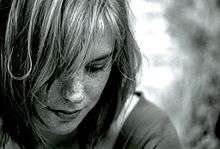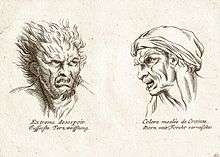.jpg)

.jpg)

.jpg)

Faces are the central sense organ complexes, for those animals that have one, normally on the ventral surface of the head. The face is the feature which best distinguishes a person, and include the visible elements of hair, forehead, eyebrow, eyelashes, eyes, nose, ears, cheeks, mouth, lips, philtrum, teeth, skin, and chin. The face has uses of expression, appearance, and identity amongst others. It also has different senses like olfaction, taste, hearing, and vision.
Quotes
- Previous studies have shown that exposure to traumatic events that put one’s life at risk may affect processing of facial expressions. Thus, for example, individuals suffering from PTSD have difficulties in differentiating between fearful and neutral faces (e.g., Felmingham, Bryant, & Gordon, 2003). Developmental studies have found that neglected or maltreated children demonstrate heightened sensitivity to anger and fearful expressions, while displaying difficulties in perceiving other expressions such as sadness and disgust (Masten et al., 2008; Pollak, Cicchetti, Hornung, & Reed, 2000; Pollak & Tolley-Schell, 2003). A recent study, which assessed the long-lasting impact of a terrorist attack, found that children who were held as hostages at the Russian town of Beslan on September 2004 by Chechen rebels were more accurate than nonexposed children in detecting threat related information such as anger in faces, which were morphed from two prototypical emotions (Scrimin, Moscardino, Capello, Altoe, & Axia, 2009; Scrimin, Moscardino, Capello, & Axia, 2008). In military veterans, however, the long-term consequences of life threatening experience on the perception of facial expressions have not been explored before, to the best of our knowledge.
- David Anaki, Tamar Brezniak, Liron Shalom, “Faces in the face of Death: Effects of exposure to life-threatening events and mortality salience on facial expression recognition in combat and noncombat military Veterans”, Emotion, 12(4):860-7 (August 2012), p.860.
- Results from the current study suggest that behavioral avoidance to certain emotional expressions, particularly negative emotional expressions, may increase delays in identifying those same emotional expressions, which may jointly serve to increase risk for adult sexual revictimization. This interaction appears to be more influential than overall accuracy in identifying facial expressions in predicting risk for adult sexual revictimization.
- Kathryn M Bell, Amy E. Naugle, "The role of emotion recognition skills in adult sexual revictimization", The Journal of Behavior Analysis of Offender and Victim Treatment and Prevention, 1(4), (January 2008).
- It is the common wonder of all men, how among so many millions of faces there should be none alike.
- Sir Thomas Browne, Religio Medici (1642), Part II, Section II.
- As clear and as manifest as the nose in a man's face.
- Robert Burton, The Anatomy of Melancholy (1621), Part III, Section III. Memb. 4. Subsec. I.
- And her face so fair
Stirr'd with her dream, as rose-leaves with the air.- Lord Byron, Don Juan (1818-24), Canto IV, Stanza 29.
- Yet even her tyranny had such a grace,
The women pardoned all, except her face.- Lord Byron, Don Juan (1818-24), Canto V, Stanza 113.
- He had a face like a benediction.
- Miguel de Cervantes, Don Quixote (1605-15), Book II, Part I, Chapter IV.
- Two studies investigated gender stereotyping in American magazine photos. Study 1 compares cover photos of men and women on face-ism, an index of the degree to which a photo focuses on the face versus the body. Photos of women are found to focus more on their bodies and photos of men on their faces, a finding consistent with previous research. This finding is strongly mediated by other variables, however, particularly the social role of the cover person. Study 2 compares the facial expressions, specifically the mouth positions, of men and women in advertisements from several popular magazines. Women are significantly more likely than men to be photographed with their mouths open, presumably portraying less serious expressions.
- Dodd, D. K., Harcar, V., Foerch, B. J., Anderson, H. T. (1989). "Face-ism and facial expressions of women in magazine photos", The Psychological Record, 39, p. 325.
- That is the great thing about our movement--that these members are uniform not only in ideas, but even, the facial expression is almost the same!
- Adolf Hitler, attributed by Jack Kirby in The Forever People, #3, National Periodical Publications, (June-July 1971).
- “You cannot see my face, for no man can see me and live.” Jehovah said further: “Here is a place near me. Station yourself on the rock. When my glory is passing by, I will place you in a crevice of the rock, and I will shield you with my hand until I have passed by. After that I will take my hand away, and you will see my back. But my face may not be seen.
- Do not be afraid because of their faces, for ‘I am with you to deliver you,’ is the utterance of Jehovah.
- Jeremiah 1:8, NWT
- Human face divine.
- John Milton, Paradise Lost (1667; 1674), Book III, line 44.
- In her face excuse
Came prologue, and apology too prompt.- John Milton, Paradise Lost (1667; 1674), Book IX, line 853.
- In summary, our results showed no sex differences in the rapid detection of emotional compared with emotionally neutral expressions. However, we did observe sex differences in the subjective ratings of facial stimuli and the relationship between ratings and RTs. Females reported a stronger qualitative response to the emotional facial expressions of others than did males. Furthermore, emotional arousal enhanced the detection of facial expressions more strongly in females than in males, whereas negative feelings facilitated the detection of facial expressions more clearly in males than in females. These findings suggest females and males differ in their subjective emotional reactions to facial expressions and that this difference leads to subsequent differences in the ways in which emotion modulates the detection of emotional facial expressions.
- Reiko Sawada, Wataru Sato, Takanori Kochiyama, Shota Uono, Yasutaka Kubota, Sayaka Yoshimura, and Motomi Toichi, "Sex Differences in the Rapid Detection of Emotional Facial Expressions", PLoS One, 2014; 9(4): (2014 Apr 11).
- All men's faces are true, whatsome'er their hands are.
- William Shakespeare, Antony and Cleopatra (1600s), Act II, scene 6, line 102.
- Thou hast a grim appearance, and thy face
Bears a command in 't: though thy tackle's torn,
Thou show'st a noble vessel.- William Shakespeare, Coriolanus (c. 1607-08), Act IV, scene 5, line 66.
- A countenance more in sorrow than in anger.
- William Shakespeare, Hamlet (1600-02), Act I, scene 2, line 232.
- God has given you one face, and you make yourselves another.
- William Shakespeare, Hamlet (1600-02), Act III, scene 1, line 149.
- There is a fellow somewhat near the door; he should be a brazier by his face.
- William Shakespeare, Henry VIII (c. 1613), Act V, scene 4, line 41.
- I have seen better faces in my time
Than stands on any shoulder that I see.- William Shakespeare, King Lear (1608), Act II, scene 2, line 99.
- There's no art
To find the mind's construction in the face.- William Shakespeare, Macbeth (1605), Act I, scene 4, line 11.
- Your face, my thane, is a book where men
May read strange matters. To beguile the time,
Look like the time.- William Shakespeare, Macbeth (1605), Act I, scene 5, line 63.
- You have such a February face,
So full of frost, of storm, of cloudiness.- William Shakespeare, Much Ado About Nothing (1598-99), Act V, scene 4, line 41.
- Compare her face with some that I shall show;
And I will make thee think thy swan a crow.- William Shakespeare, Romeo and Juliet (1597), Act I, scene 2, line 91.
- Writing for Military Images, Luther says that the array of facial landmarks used to compare photographs enables CWPS to find matches even if a soldier’s facial hair changes or an existing snapshot captures him from a different angle. This feat is made all the more impressive by the limitations of Civil War images. By the start of the war, photographers were beginning to develop prints from negatives, a delicate process that nevertheless opened up the possibilities of the nascent medium. As Eisen of Slate notes, in addition to the quality and coloring of these images, there were an array of limitations that make it a challenge to identify historical photographs today. Take, for instance, the prevalence of thick beards and mustaches, which could obscure vital facial features.
- Meilan Solly, “Facial Recognition Software Is Helping Identify Unknown Figures in Civil War Photographs”, Smithsonian, (November 21, 2018).
- Patients with schizophrenia demonstrate abnormalities in early visual encoding of facial features that precedes the ERP response typically associated with facial affect recognition. This suggests that affect recognition deficits, at least for happy and sad discrimination, are secondary to faulty structural encoding of faces. The association of abnormal face encoding with delusions may denote the physiological basis for clinical misidentification syndromes.
- Bruce I. Turetsky, Christian G. Kohler, Tim Indersmitten, Mahendra T. Bhati, Dorothy Charbonnier, and Ruben C. Gur, “Facial Emotion Recognition in Schizophrenia: When and Why Does It Go Awry?”, Schizophr Res. 2007 Aug; 94(1-3): 253–263.
Hoyt's New Cyclopedia Of Practical Quotations
- Quotes reported in Hoyt's New Cyclopedia Of Practical Quotations (1922), p. 250-52.
- A face to lose youth for, to occupy age
With the dream of, meet death with.- Robert Browning, A Likeness.
- Showing that if a good face is a letter of recommendation, a good heart is a letter of credit.
- Edward Bulwer-Lytton, What Will He Do With It? (1858), Book II. Title of Ch, XI.
- And to his eye
There was but one beloved face on earth,
And that was shining on him.- Lord Byron, The Dream, Stanza 2.
- There is a garden in her face,
Where roses and white lilies blow;
A heavenly paradise is that place,
Wherein all pleasant fruits do grow.
There cherries grow that none may buy,
Till cherry ripe themselves do cry.- Campion claims these in note To Reader, Fourth Book of Airs. Arber in English Garner, follows original. Attributed to Richard Allison by W. D. Adams, Frederick Locker-Lampson, Charles Mackay. To Campion by Ernest Rhys, A. H. Bullen.
- The magic of a face.
- Thomas Carew, Epitaph on the Lady S——.
- The face the index of a feeling mind.
- George Crabbe, Tales of the Hall.
- Well had the boding tremblers learn'd to trace
The day's disasters in his morning face.- Oliver Goldsmith, The Deserted Village (1770), line 199.
- Her face betokened all things dear and good,
The light of somewhat yet to come was there
Asleep, and waiting for the opening day,
When childish thoughts, like flowers, would drift away.- Jean Ingelow, Margaret in the Xebec, Stanza 57.
- How some they have died, and some they have left me,
And some are taken from me; all are departed;
All, all are gone, the old familiar faces.- Charles Lamb, The Old Familiar Faces.
- A face that had a story to tell. How different faces are in this particular! Some of them speak not. They are books in which not a line is written, save perhaps a date.
- Henry Wadsworth Longfellow, Hyperion (1839), Book I, Chapter IV.
- These faces in the mirrors
Are but the shadows and phantoms of myself.- Henry Wadsworth Longfellow, Masque of Pandora, Part II. The House of Epimetheus, line 72.
- The light upon her face
Shines from the windows of another world.
Saints only have such faces.- Henry Wadsworth Longfellow, Michael Angelo, Part II. 6.
- Oh! could you view the melody
Of every grace,
And music of her face,
You'd drop a tear,
Seeing more harmony
In her bright eye,
Than now you hear.- Richard Lovelace, Orpheus to Beasts, Stanza 2.
- Was this the face that launch'd a thousand ships,
And burnt the topless towers of Ilium?
Sweet Helen, make me immortal with a kiss.—
Her lips suck forth my soul; see, where it flies!—- Christopher Marlowe, Faustus.
- Vous avez bien la face descouverte; moi je suis tout face.
- You have your face bare; I am all face.
- Michel de Montaigne, Essays, Volume I, Chapter XXXV. Answer of a naked beggar who was asked whether he was not cold. Same in Fuller, Worthies. Berkshire, p. 82. 3rd Ed. (1662).
- Cheek * * *
Flushing white and mellow'd red;
Gradual tints, as when there glows
In snowy milk the bashful rose.- Thomas Moore, Odes of Anacreon. Ode XV, line 27.
- With faces like dead lovers who died true.
- Dinah Craik, Indian Summer.
- Sæpe tacens vocem verbaque vultus habet.
- Often a silent face has voice and words.
- Ovid, Ars Amatoria, Book I. 574.
- If to her share some female errors fall
Look on her face, and you'll forget 'em all.- Alexander Pope, The Rape of the Lock (1712), Canto II, line 17.
- Lift thou up the light of thy countenance upon us.
- Psalms, IV. 6.
- A sweet attractive kinde of grace,
A full assurance given by lookes,
Continuall comfort in a face
The lineaments of Gospell bookes.- Matthew Royden, Elegie: or a Friend's Passion for his Astrophill (Sir Philip Sidney).
- On his bold visage middle age
Had slightly press'd its signet sage,
Yet had not quenched the open truth
And fiery vehemence of youth;
Forward and frolic glee was there,
The will to do, the soul to dare.- Walter Scott, Lady of the Lake (1810), Canto I, Stanza 21.
- Sea of upturned faces.
- Walter Scott, Rob Roy, Volume II, Chapter XX. Daniel Webster. Speech. Sept. 30, 1842.
- In thy face
I see thy fury: if I longer stay
We shall begin our ancient bickerings.- William Shakespeare, Henry VI, Part II (c. 1590-91), Act I, scene 1, line 142.
- Thus is his cheek the map of days outworn.
- William Shakespeare, Sonnet LXVIII.
- An unforgiving eye, and a damned disinheriting countenance.
- Richard Brinsley Sheridan, The School for Scandal (1777), Act IV, scene 1.
- Her angel's face,
As the great eye of heaven, shyned bright,
And made a sunshine in the shady place.- Edmund Spenser, The Faerie Queene (1589-96), Book I, Canto III, Stanza 4.
- Her cheeks so rare a white was on,
No daisy makes comparison;
(Who sees them is undone);
For streaks of red were mingled there,
Such as are on a Cath'rine pear,
(The side that's next the Sun).- Sir John Suckling, A Ballad Upon a Wedding, Stanza 10.
- Her face is like the Milky Way i' the sky,—
A meeting of gentle lights without a name.- Sir John Suckling, Brennoralt, Act III.
- White rose in red rose-garden
Is not so white;
Snowdrops, that plead for pardon
And pine for fright
Because the hard East blows
Over their maiden vows,
Grow not as this face grows from pale to bright.- Algernon Charles Swinburne, Before the Mirror.
- A face with gladness overspread!
Soft smiles, by human kindness bred!- William Wordsworth, To a Highland Girl.
- My face. Is this long strip of skin
Which bears of worry many a trace,
Of sallow hue, of features thin,
This mass of seams and lines, my face?- Edmund Yates, Aged Forty.
See also
External links
This article is issued from
Wikiquote.
The text is licensed under Creative
Commons - Attribution - Sharealike.
Additional terms may apply for the media files.
